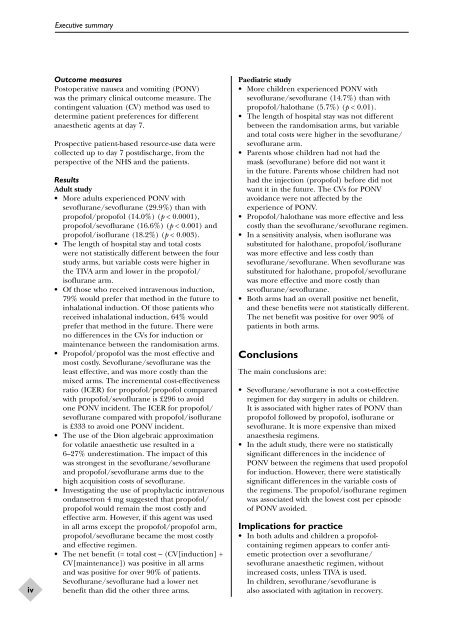Aanesthetic Agents for Day Surgery - NIHR Health Technology ...
Aanesthetic Agents for Day Surgery - NIHR Health Technology ...
Aanesthetic Agents for Day Surgery - NIHR Health Technology ...
You also want an ePaper? Increase the reach of your titles
YUMPU automatically turns print PDFs into web optimized ePapers that Google loves.
iv<br />
Executive summary<br />
Outcome measures<br />
Postoperative nausea and vomiting (PONV)<br />
was the primary clinical outcome measure. The<br />
contingent valuation (CV) method was used to<br />
determine patient preferences <strong>for</strong> different<br />
anaesthetic agents at day 7.<br />
Prospective patient-based resource-use data were<br />
collected up to day 7 postdischarge, from the<br />
perspective of the NHS and the patients.<br />
Results<br />
Adult study<br />
• More adults experienced PONV with<br />
sevoflurane/sevoflurane (29.9%) than with<br />
propofol/propofol (14.0%) (p < 0.0001),<br />
propofol/sevoflurane (16.6%) (p < 0.001) and<br />
propofol/isoflurane (18.2%) (p < 0.003).<br />
• The length of hospital stay and total costs<br />
were not statistically different between the four<br />
study arms, but variable costs were higher in<br />
the TIVA arm and lower in the propofol/<br />
isoflurane arm.<br />
• Of those who received intravenous induction,<br />
79% would prefer that method in the future to<br />
inhalational induction. Of those patients who<br />
received inhalational induction, 64% would<br />
prefer that method in the future. There were<br />
no differences in the CVs <strong>for</strong> induction or<br />
maintenance between the randomisation arms.<br />
• Propofol/propofol was the most effective and<br />
most costly. Sevoflurane/sevoflurane was the<br />
least effective, and was more costly than the<br />
mixed arms. The incremental cost-effectiveness<br />
ratio (ICER) <strong>for</strong> propofol/propofol compared<br />
with propofol/sevoflurane is £296 to avoid<br />
one PONV incident. The ICER <strong>for</strong> propofol/<br />
sevoflurane compared with propofol/isoflurane<br />
is £333 to avoid one PONV incident.<br />
• The use of the Dion algebraic approximation<br />
<strong>for</strong> volatile anaesthetic use resulted in a<br />
6–27% underestimation. The impact of this<br />
was strongest in the sevoflurane/sevoflurane<br />
and propofol/sevoflurane arms due to the<br />
high acquisition costs of sevoflurane.<br />
• Investigating the use of prophylactic intravenous<br />
ondansetron 4 mg suggested that propofol/<br />
propofol would remain the most costly and<br />
effective arm. However, if this agent was used<br />
in all arms except the propofol/propofol arm,<br />
propofol/sevoflurane became the most costly<br />
and effective regimen.<br />
• The net benefit (= total cost – (CV[induction] +<br />
CV[maintenance]) was positive in all arms<br />
and was positive <strong>for</strong> over 90% of patients.<br />
Sevoflurane/sevoflurane had a lower net<br />
benefit than did the other three arms.<br />
Paediatric study<br />
• More children experienced PONV with<br />
sevoflurane/sevoflurane (14.7%) than with<br />
propofol/halothane (5.7%) (p < 0.01).<br />
• The length of hospital stay was not different<br />
between the randomisation arms, but variable<br />
and total costs were higher in the sevoflurane/<br />
sevoflurane arm.<br />
• Parents whose children had not had the<br />
mask (sevoflurane) be<strong>for</strong>e did not want it<br />
in the future. Parents whose children had not<br />
had the injection (propofol) be<strong>for</strong>e did not<br />
want it in the future. The CVs <strong>for</strong> PONV<br />
avoidance were not affected by the<br />
experience of PONV.<br />
• Propofol/halothane was more effective and less<br />
costly than the sevoflurane/sevoflurane regimen.<br />
• In a sensitivity analysis, when isoflurane was<br />
substituted <strong>for</strong> halothane, propofol/isoflurane<br />
was more effective and less costly than<br />
sevoflurane/sevoflurane. When sevoflurane was<br />
substituted <strong>for</strong> halothane, propofol/sevoflurane<br />
was more effective and more costly than<br />
sevoflurane/sevoflurane.<br />
• Both arms had an overall positive net benefit,<br />
and these benefits were not statistically different.<br />
The net benefit was positive <strong>for</strong> over 90% of<br />
patients in both arms.<br />
Conclusions<br />
The main conclusions are:<br />
• Sevoflurane/sevoflurane is not a cost-effective<br />
regimen <strong>for</strong> day surgery in adults or children.<br />
It is associated with higher rates of PONV than<br />
propofol followed by propofol, isoflurane or<br />
sevoflurane. It is more expensive than mixed<br />
anaesthesia regimens.<br />
• In the adult study, there were no statistically<br />
significant differences in the incidence of<br />
PONV between the regimens that used propofol<br />
<strong>for</strong> induction. However, there were statistically<br />
significant differences in the variable costs of<br />
the regimens. The propofol/isoflurane regimen<br />
was associated with the lowest cost per episode<br />
of PONV avoided.<br />
Implications <strong>for</strong> practice<br />
• In both adults and children a propofolcontaining<br />
regimen appears to confer antiemetic<br />
protection over a sevoflurane/<br />
sevoflurane anaesthetic regimen, without<br />
increased costs, unless TIVA is used.<br />
In children, sevoflurane/sevoflurane is<br />
also associated with agitation in recovery.
















